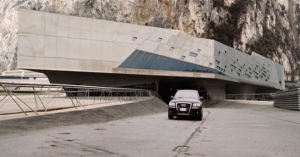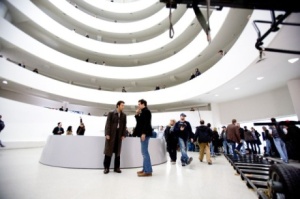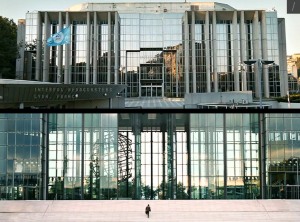I just recently saw the new film, Moonrise Kingdom, and felt like it was a worthy movie worth reviewing and reading up on. Hence, I stumbled across this review by Brian Juergens and felt like I wanted to share his review because it was written so well….. I must say, that this is a must see movie. A great new Wes Anderson film, with a surreal sense of style and ambiance. As two starcrossed storybook lovers venture off hand in hand to escape the dull and drearly lives they lead on the small island of New Pensance, which leads to a man hunt full of comical humor and a sense of enlightenment through a tale of trying to escape from some of the basic impriosonments that the film portrays of the 1960’s. Wes Anderson adds a quirky and unique spin on a simple story that has turned into a delicately planned film full of common sense, misory, and a blunt sense of humor. Its as if instagram was developed from this film. Anyways…. read this review below and see that I have added in links to references throughout the post:
A mint-condition vintage rucksack packed to bursting with well-curated nostalgia, Wes Anderson‘s Moonrise Kingdom might be his most Wes Andersony film yet. A sidewalk chalk mural of Push-Up orange, lemonade yellow and verdant green, it might also be the summer’s most perfect summer movie. After all, scout camps, sailboats, and first love are just as good a summertime recipe as marshmallows, chocolate bars, and graham crackers.
Moonrise Kingdom is a kooky and surprisingly heartfelt pleasure. Anderson’s proudly odd and slyly affecting bedtime story about two unhappy, mismatched children who devise an elaborate long-distance plot to run away from home reads like the stuff of the most wonderfully twisted children’s tales. And like many of those tales, Kingdom has a way of distracting you with its elaborate compositions and inspired design so that it can sneak behind you to yank at the rug beneath your feet. Sure – like all of Anderson’s films, the movie looks great, it’s peppered with beloved and familiar faces, and it celebrates the twee, the outcast, and the beautifully broken. But unlike some of his gorgeous-but-tedious previous efforts, underneath Kingdom’s impossibly thick sailing sweater lies a very real and beating heart.
Moonrise‘s simple story is this: Sam (Jared Gilman), a young, bespectacled orphan, goes AWOL from Camp Ivanhoe in the summer of 1965 to run away with his first love, the moody Suzy (Kara Hayward). Suzy lives in a storybook house at the opposite end of the island populated with adorable moppet siblings who spend rainy days listening to Benjamin Britten and ignoring their parents, married attorneys Walt (Bill Murray) and Laura (Frances McDormand) Bishop.
When Sam’s troop leader, Scout Master Ward (Edward Norton, in rare nice-guy mode), discovers that Sam has gone missing, he and the remaining troops put their patch-proven skills to work in order to track him down. Over at the Bishop house, mom and pop enlist the help of sad-sack cop Captain Sharp (Bruce Willis) to find their daughter. As the lovers-on-the-run make their way towards their rendezvous, a parka-swathed narrator (Bob Balaban) warns us that a major storm is coming that could wipe out the entire island.
Once Sam and Suzy find one another, the film’s central coming-of-age story kicks in, with lots of awkward politeness and clumsy attempts at romance tucked into the ravishingly beautiful inlet that the kids decide to call their new home. Much of the charm of this part of the tale comes from the fact that the kids are awkward adults trapped in tiny bodies – they listen to French pop music, speak in stilted, formal cadences and read aloud to one another like dowager aunts.
It’s kind of like The Blue Lagoon as retold by a middle school 4H club.
On the flipside of these children who act like adults are the actual adults, who act like children. Temper tantrums (including one hilariously tossed shoe), passive aggression, and finger-pointing are the name of the game until an ominous call from Social Services (that’s the character’s name as well as her title, for all we know) indicates that the awkward and rather hapless Sam may be sent to a juvenile facility once he’s found. The fact that the film’s true villain is played by the luminous Tilda Swinton in a spectacularly unflattering royal blue skirt suit and not one, but TWO wigs, makes it all the more delicious.
And all the while, the unexpected storm brews, both off the coast and between the adults as they try to locate their kids. I’ve heard lots of viewers going on about the star-crossed tween lovers in Kingdom, which is fine – they’re cute, in a fetal hipster kind of way. But for me the real story at the heart of Kingdom is that of the parents. I can’t speak too much about it without stealing the film’s wonderfully bittersweet core, but for me, in the end the adults stole the show. Willis, in particular, is wonderfully guileless as the island’s well-meaning, lovesick authority figure, and any Frances McDormand is good Frances McDormand, as far as I’m concerned.
Also on proud display is Anderson’s uncanny knack for creating striking and uniquely Andersonian imagery. It’s evident how much care went into the designs for each raccoon patch, utility knife, canoe, and invented storybook that pepper the film like so many long-forgotten treasures. Anderson can manufacture nostalgia like no other filmmaker can – and while everything in Kingdom is a fabrication, it has the tug of actual memory. I could see how some viewers might not go for his mechanically precise camera movements and shots framed with impossible symmetry, but it’s hard to argue the fanatical care with which he composes his images.
Here he curates his vision with unbridled enthusiasm, handling the film almost more as one would an animated movie – in fact, you can catch glimpses of his last film, The Fantastic Mr. Fox all over the place, from the posture of Suzy the first time we see her (shoulders hunched and head cocked ever so slightly, her chin the mirror of a fox’s pointed muzzle) to the film’s centerpiece, a gloriously crafted production of Britten’s “Noye’s Fludd” opera for children, which overflows with cleverly composed animal costumes and hand-hewn stagecraft.
I’m a devoted fan of Anderson’s first film, Rushmore (and was happy to see Jason Schwartzman appear in Kingdom as the rather fey senior member of another troop), but haven’t been terribly impressed by anything he has done since. Kingdom is the first film where I feel he completely embraces his talents as a visual artist while also managing to spin an entertaining and emotionally resonant yarn. It’s a clever little film, a beautiful work of art, and a touching tale that will stay with you long after the brilliant closing credits (stay and listen – they’re marvelous). While summer at the moviehouse these days means spectacle and supepowers, I think Kingdom might be the season’s quiet, bespectacled hero.
reference:
http://www.afterelton.com/content/2012/07/review-moonrise-kingdom?page=1%2C0
















